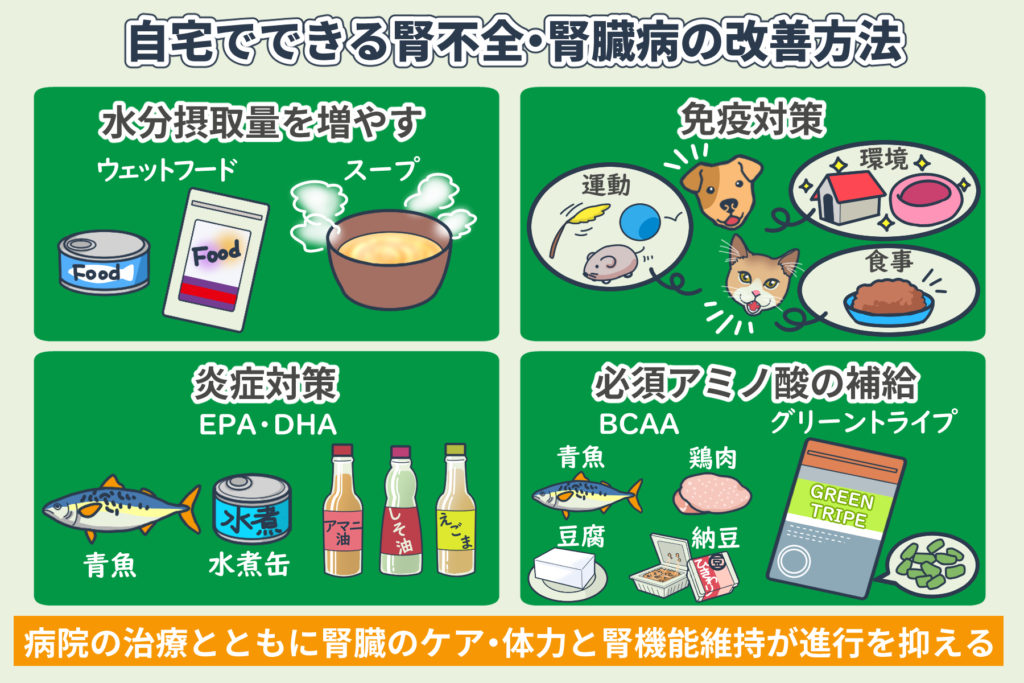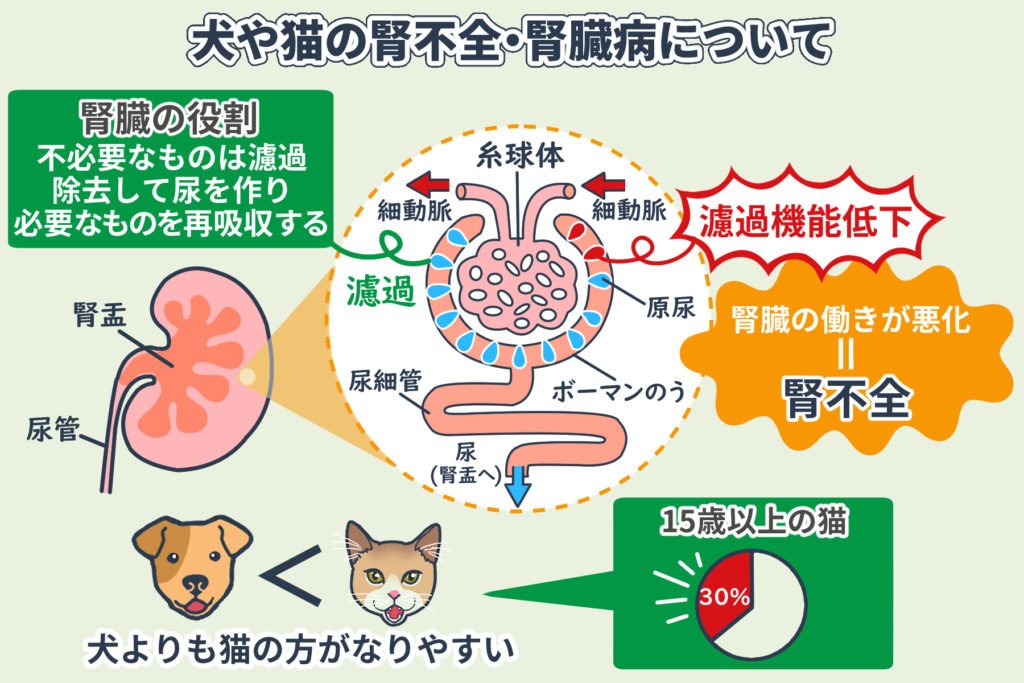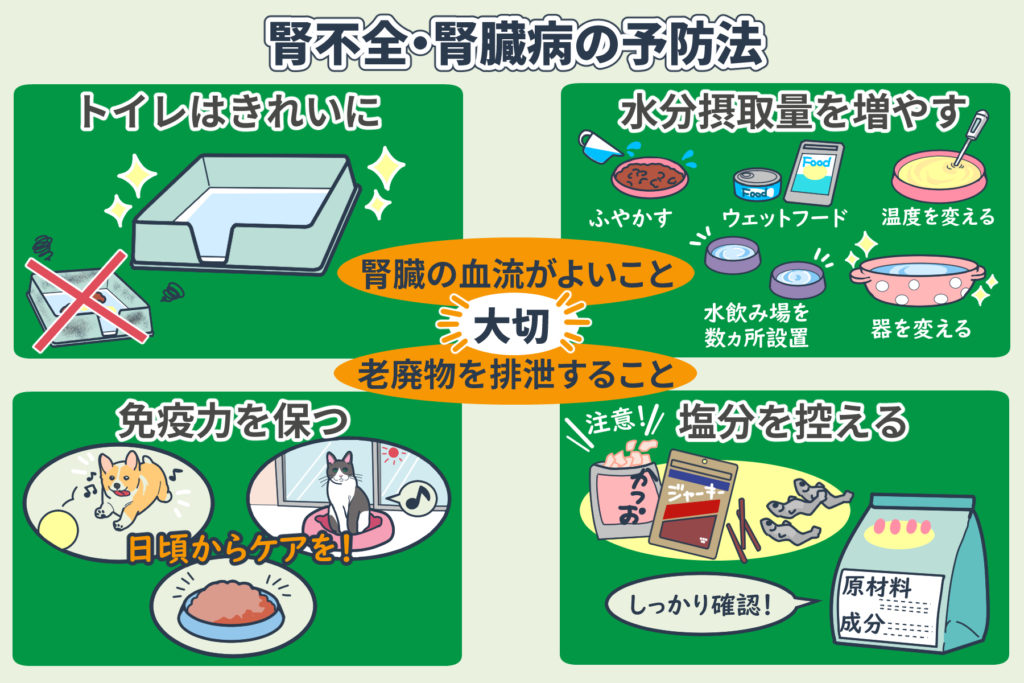Here is a summary of the causes and types of kidney failure in dogs and cats, the symptoms of kidney failure, and ways to improve the condition.
In particular, many cats suffer from kidney failure. However, even if your pet is diagnosed with kidney failure, you can expect to improve kidney function stability and enhancement by improving immunity with Cordy or providing necessary nutrients.
- Damaged kidneys cannot be restored, so it is crucial to maintain function and reduce the load on the kidneys to prevent the progression of symptoms.
- In pre-renal or post-renal cases, it is important to treat the underlying cause. In cases of acute kidney failure, immediate treatment is necessary.
- For pets with diseases such as tumors, it may help reduce side effects associated with aggressive treatment and maintain the quality of life for pets considered untreatable.
If you have any concerns or questions about the illnesses or symptoms of your dog or cat, please feel free to contact us.
目次
Improving Kidney Failure and Kidney Disease

Many older cats, in particular, exhibit a decline in kidney function or have kidneys that are not working properly.
Damaged kidneys cannot be restored.
Therefore, to prevent the progression of kidney failure symptoms, it is crucial to maintain the function of the remaining kidneys and reduce the load on the kidneys.
By administering drips (intravenous or subcutaneous) to promote the excretion of toxins, we aim to alleviate symptoms and improve kidney function.
In pre-renal or post-renal cases, it is also important to treat the underlying diseases causing the condition.
To slow the progression of kidney failure, alongside treatment at animal hospitals, it is essential to take care of the kidneys and maintain physical strength and kidney function.
Here are some recommended methods that can be done at home.
If your pet’s vitality and appetite begin to recover, it means your efforts are paying off.
- Increase fluid intake with wet food or soup
- Boost immunity with Cordy
- Manage inflammation with EPA/DHA
- Supplement essential amino acids with BCAA and green tripe
For any questions or concerns regarding the use of Cordy, EPA/DHA, or BCAA/green tripe, please feel free to contact us.
Kidney Failure and Kidney Disease in Dogs and Cats

This disease can occur in both dogs and cats, but it is more common in cats. Reports from overseas state that 30% of cats over 15 years old suffer from chronic kidney failure.
One suggested reason for the higher incidence of kidney failure in cats is their low water intake, which places a burden on the kidneys to produce concentrated urine, making them more prone to kidney disease as they age.
Additionally, a 2016 study suggested that a special protein called “AIM” might not be functioning adequately in cats’ kidneys, which could be a factor in chronic kidney disease.
In both humans and animals, the kidneys act like a coffee filter. They filter and remove waste products and salts while reabsorbing necessary substances to produce urine, which helps regulate body fluids. When this function is compromised, waste products build up in the body, causing various symptoms.
The failure to effectively expel waste products and toxins can lead to conditions such as ‘Uremia‘ or ‘Hyperkalemia‘.
The kidney, like the liver, is often referred to as a “silent organ,” and it is believed that by the time abnormalities appear in a blood test, more than 70% of kidney function has already been lost.
Whether in humans, dogs, or cats, once the kidneys stop functioning properly (become damaged), they cannot recover. Therefore, managing the damage to the cells of the kidneys that are still functioning is critical in coping with renal failure.
Although managing renal failure is challenging, dietary therapy and treatments can reduce the burden on the kidneys, allowing for a more peaceful remaining life.
Types of Renal Failure

Renal failure can be classified into three types depending on the location of the damage.
The kidneys are supplied by many blood vessels, and pre-renal failure is caused by issues in the vascular system before reaching the kidneys, leading to changes in the blood flow (reduced blood flow) to the kidneys. Causes of pre-renal failure include dehydration, anemia, heart failure, endocrine disorders, and heartworm disease.
② Renal
This type refers to renal failure caused by problems arising within the kidneys themselves. Causes include parasites, infections, trauma, tumors, and drug poisoning. Congenital abnormalities (abnormalities present at birth) are also included in this category.
③ Post-renal
This type of renal failure is caused by abnormalities in the urinary system after it leaves the kidneys. Causes include urolithiasis (urinary/bladder stones), tumors in the bladder, and urinary obstruction.
Renal failure can also be classified into two types based on progression: acute and chronic.
As the name suggests, this type of renal failure occurs suddenly. It is often caused by urinary obstructions due to stones or by drugs/toxins.
It is a terrifying disease that can rapidly worsen in just one day.
② Chronic Renal Failure
Chronic renal failure occurs due to the gradual dysfunction of the kidneys’ filtration capacity.
It progresses over several months to years, and by the time symptoms become noticeable, more than 70% of the kidney’s function may already be impaired.
It is said that one in three cats and one in ten dogs will develop chronic kidney disease during their lifetime, making it one of the leading causes of death, especially in cats.
Symptoms of Renal Failure
In acute cases, you may observe symptoms such as loss of appetite, vomiting, diarrhea, and lethargy.
Some pets may exhibit signs of pain in their kidneys, leading to increased vocalizations or aggression.
In chronic cases, due to the gradual progression, noticeable symptoms may not always be present, but generally, increased water intake and increased urination are observed.
Other symptoms may include characteristic bad breath (ammonia odor) and anemia (due to decreased production of erythropoietin, which stimulates red blood cell production), as well as constipation due to dehydration.
If renal failure progresses and uremia develops, it can lead to neurological symptoms such as seizures and coma.
Diagnosis
Blood tests may show elevated levels of BUN (blood urea nitrogen), creatinine (Cre), and phosphorus (IP), along with low red blood cell counts.
(Abnormal values may also be seen in other parameters)
Urinalysis involving urine specific gravity, UPC (urine protein/creatinine ratio), and UAC (urine albumin/creatinine ratio) values can help diagnose renal failure.
Renal failure is categorized using the ‘IRIS staging system,’ which helps determine the extent of remaining kidney function based on the stage.
| IRIS Stages | |||
|---|---|---|---|
| Stage | Cre (Creatinine) | BUN (Blood Urea Nitrogen) | Remaining Renal Function |
| Stage 1 | Below 1.4 in dogs Below 1.6 in cats |
No abnormality | 33–100% |
| Stage 2 | 1.4–2.0 in dogs 1.6–2.8 in cats |
Mild elevation | 25–33% |
| Stage 3 | 2.0–5.0 in dogs 2.9–5.0 in cats |
Moderate elevation | 10–25% |
| Stage 4 | Above 5 in both dogs and cats | Severe elevation | Less than 10% |
Additionally, since 2015, Idexx (Idexx) has introduced the ‘SDMA’ test, which can detect chronic renal failure at an early stage, so it is recommended to include this test as well.
Other diagnostic methods may include X-rays, ultrasound, contrast imaging, and blood pressure measurement.
Treatment Methods

Typically, intravenous or subcutaneous fluids are administered to promote the excretion of toxins, aiming to alleviate symptoms and improve renal function.
In cases of prerenal or postrenal conditions, it is also important to treat the underlying diseases causing these conditions. In cases of acute renal failure, rapid deterioration of symptoms can lead to death, so prompt treatment is essential.
If treatment is delayed or the kidney damage is extensive, it may progress to chronic renal failure.
For chronic renal failure, in addition to fluid therapy, measures such as dietary changes, oral medications, and injectable medications can be used to slow the decline in renal function and prevent the worsening of symptoms.
Generally, subcutaneous fluids are absorbed within half a day to a day, but if absorption does not occur, the excess fluid may appear as edema.
Edematous areas tend to get cold easily, which can impede circulation, making waste excretion less efficient, and leading to decreased metabolism and lowered immunity.
Since subcutaneous fluids are often administered between the shoulder blades, edema is more likely to occur in the front legs, which can result in abnormal walking or paw shaking behaviors.
Rapid breathing or open-mouthed breathing may also occur.
The day after administering subcutaneous fluids, please check at home to ensure the fluid has been properly absorbed. If it has not been absorbed, adjust the amount of subcutaneous fluids accordingly.
Pitfalls of Kidney Prescription Diet
When kidney values exceed the normal range, a switch to a prescription diet is generally recommended.
The idea behind prescription diets is to reduce the burden on the kidneys by minimizing waste products, so these diets typically contain low amounts of protein.
However, considering that dogs and cats are naturally carnivorous animals (especially cats, which are obligate carnivores), excessive restriction of protein may lead to an energy deficit, resulting in improved kidney values but a lack of physical strength and vitality in many pets.
In fact, there is no clear evidence that protein restriction can prevent the progression of kidney disease in cats.
- Ensuring adequate fluid intake
- Using appropriate amounts of protein
- Using high-quality protein (with an amino acid score close to 100)
- Increasing fats
Fluid Intake
Consider switching from dry food to wet food or preparing homemade meals with plenty of soup.
Appropriate Protein
Since each individual has different capacities for processing protein, try using foods with slightly lower protein content than what you are currently feeding.
Regular blood tests can help monitor changes in kidney values and help determine the optimal protein amount for your pet.
High-Quality Protein
The amino acid score is an indicator of protein quality—the closer to 100, the fewer waste products generated during protein breakdown, which reduces the burden on the kidneys.
However, high-scoring amino acid foods (meat, fish, eggs) are also high in protein, so start with small amounts.
For pets with decreased kidney function, administering essential amino acids like BCAA can help improve symptoms.
Also, green tripe is recommended.
Increasing Fats
Reducing protein intake can lead to an overall energy (calorie) deficit.
If there’s an energy deficiency, the body’s proteins (such as muscles) will be used, resulting in an increase in waste products.
To prevent this, energy must be supplemented with carbohydrates and fats. However, both dogs and cats are not very efficient at digesting carbohydrates.
Especially in cats, many have grain intolerances and excel at metabolizing fats more than carbohydrates.
There are various types of fats, but in cases of renal failure where inflammation may be present in the kidneys, omega-3 fatty acids are recommended to reduce inflammation.
Sources of omega-3 fatty acids include plant-based oils like flaxseed oil and perilla oil, as well as animal-based EPA and DHA.
Plant-based omega-3 fatty acids are converted in the body into animal-based omega-3 fatty acids, which exhibit anti-inflammatory and anti-tumor effects. However, some dogs and cats may not efficiently carry out this conversion.
To ensure the desired effects, it’s recommended to directly provide EPA and DHA in the form of krill oil (EPA/DHA from Antarctic krill).
※ Excessive fat intake can strain the pancreas and potentially cause pancreatitis, so start with small amounts.
Furthermore, using Cordyceps to support kidney function and boost the immune system is also crucial.
Prevention Methods

It is also important to supplement BCAAs for dogs and cats with decreased stamina and poor liver or kidney function.
Paying attention to the diet of dogs and cats on a daily basis can help prevent various diseases.
You can check the list of articles related to diet that you should pay attention to on a daily basis here.
>>Check Articles Related to Diet
Unlike us, it is challenging to encourage dogs and cats to drink water proactively. Especially for cats, whose ancestors lived in deserts, their water intake tends to be lower compared to dogs.
Additionally, many pets are currently fed dry food, which means that their water intake from diet is virtually zero.
Moreover, simply increasing the amount of water intake is not meaningful without ensuring the pet properly urinates to expel waste products.
Some dry foods contain high levels of salt to enhance palatability for dogs and cats.
Particularly, lower-quality products tend to have higher salt content, and such foods generally contain a lot of additives like flavorings.
Limiting high-salt foods can reduce the burden on the kidneys, so it is also recommended to avoid treats, jerky, dried bonito flakes, and dried sardines.
When using commercial pet food, please be sure to check the ingredients and nutritional information thoroughly before purchasing. For early detection, especially once your pet reaches senior age, conduct regular blood and urine tests.
Additionally, in the case of cats, they may avoid using a dirty litter box.
Holding in urine can strain the kidneys, so maintaining litter box hygiene is crucial.
Cats often develop kidney failure around the age of six, so be vigilant about changes in daily water intake and urination amounts.
A decline in immunity also affects kidney health.
Immunity is a crucial factor in maintaining overall body balance, and a drop in immunity can lead to various diseases, not just kidney failure.
To help your pet lead a healthy and peaceful life, daily care is essential.
Cordy supplement holds the potential of supporting health by restoring the body’s self-regulating immunity.
For pets, such as dogs, cats, and exotics, suffering from conditions like tumors, Cordy can help reduce side effects from aggressive treatments and may assist in maintaining quality of life when no other options are available.
Moreover, there are cases where administering Cordy, which contains organic germanium, has improved kidney values through its blood circulation promoting effects.
If you have any questions, please feel free to contact us.
監修獣医師:林美彩 所属クリニック:chicoどうぶつ診療所

代替療法と西洋医学、両方の動物病院での勤務経験と多数のコルディの臨床経験をもつ。 モノリス在籍時には、一般的な動物医療(西洋医学)だけでは対応が困難な症例に対して多くの相談を受け、免疫の大切さを痛烈に実感する。
ペットたちの健康維持・改善のためには薬に頼った対処療法だけではなく、「普段の生活環境や食事を見直し、自宅でさまざまなケアを取り入れることで免疫力を維持し、病気にならない体づくりを目指していくことが大切である」という考えを提唱し普及活動に従事している。
所属:

この記事が気に入ったら
いいね ! しよう
サイト内検索



